Euronet’s money transfer division (Ria and Xe) saw solid growth in 2024, but the company also talked more about the potential of its global real-time payments platform Dandelion. We’ve taken a closer look at the company’s latest results here.
Euronet’s money transfer revenues (driven by Ria and Xe) rose 9% in Q4 2024 to $441.9m, driving full-year revenues up 8% to $1.7bn. Overall, the wider company saw $4bn in revenue for FY 2024, also up 8%. Investors responded positively to the results, with Euronet’s share price rising by 10% on the day it released its earnings.
Digitally originated transactions grew 33%, continuing Euronet’s shift towards digital money transfers and away from its ATMs business. Beyond digital growth, the company’s development of its various platforms to support banks and fintechs – particularly its wholesale cross-border payments platform Dandelion and its payments processing platform Ren – could signal a continued change in Euronet’s revenue mix in the future.
Executives highlighted its B2B2X platform Dandelion could help it capture an industry “nearly 20 times the size of the remittance market”, with a number of major banking partnerships in the pipeline expected to propel its money transfer segment.
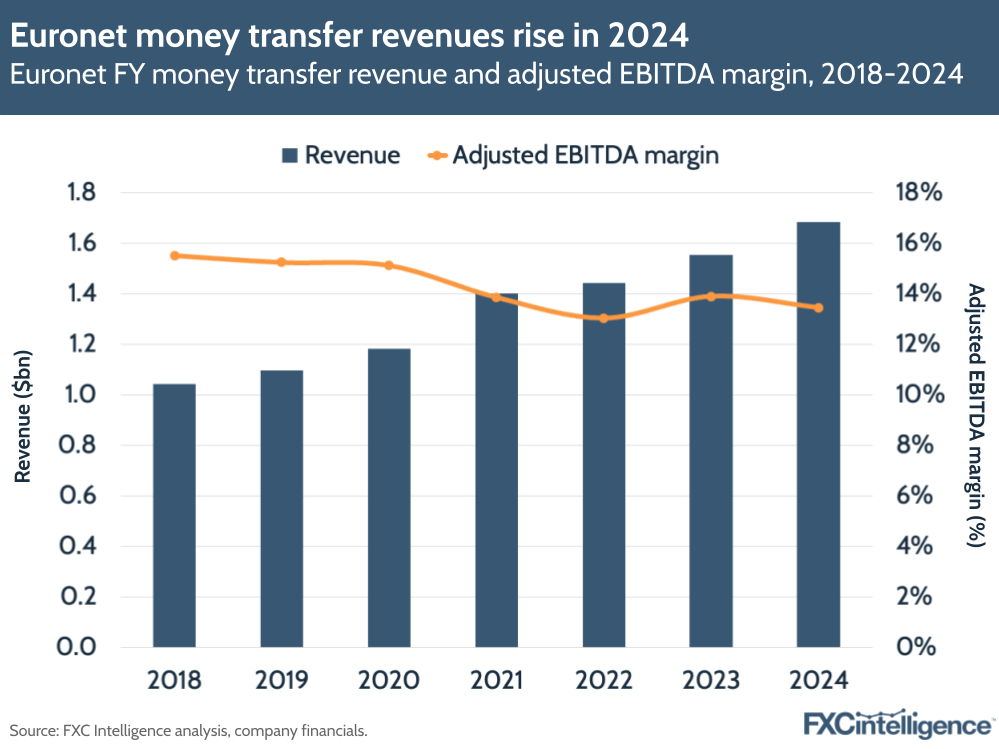
Operating costs are continuing to grow for Euronet, but money transfers have consistently helped the company grow its profits, with Euronet’s company-wide adjusted EBITDA rising 10% to $679m and driving a margin of 17%. Money transfers saw an EBITDA of $64.4m in Q4 2024, a 9% increase YoY, driving a margin of 15%. For the full year, EBITDA was up 5% to $227m, with a margin of 13%.
In this report, we take a closer look at what continues to drive the strength of digital for the Euronet, its upcoming strategy and also a closer look at its Dandelion platform and how it aligns with an ongoing move towards “platformification” within cross-border payments.
The impact of money transfers on Euronet’s revenues in 2024
Money transfers were driven by 14% growth in US outbound transactions in Q4 2024, with these transactions growing 12% over the full year. Internationally originated transactions grew 11% in both Q4 and FY 2024, while Xe – Euronet’s digital-first platform – saw transaction growth of 8% for Q4 2024 and 16% growth for the full year.
The company called out some bigger partnerships driving volumes in the quarter, including a collaboration with PLS Financial Services, which the company said yielded “substantial volume” with transactions in 160 countries and territories.
Money transfer revenues have consistently taken the largest share of Euronet’s revenues in recent years. The money transfers segment made up 42% of revenue for Euronet in 2024, compared to 29% each for EFT Processing (Euronet’s ATMs and PoS terminal solutions) and epay (which spans payment processing and prepaid card solutions), not including deducted corporate expenses.
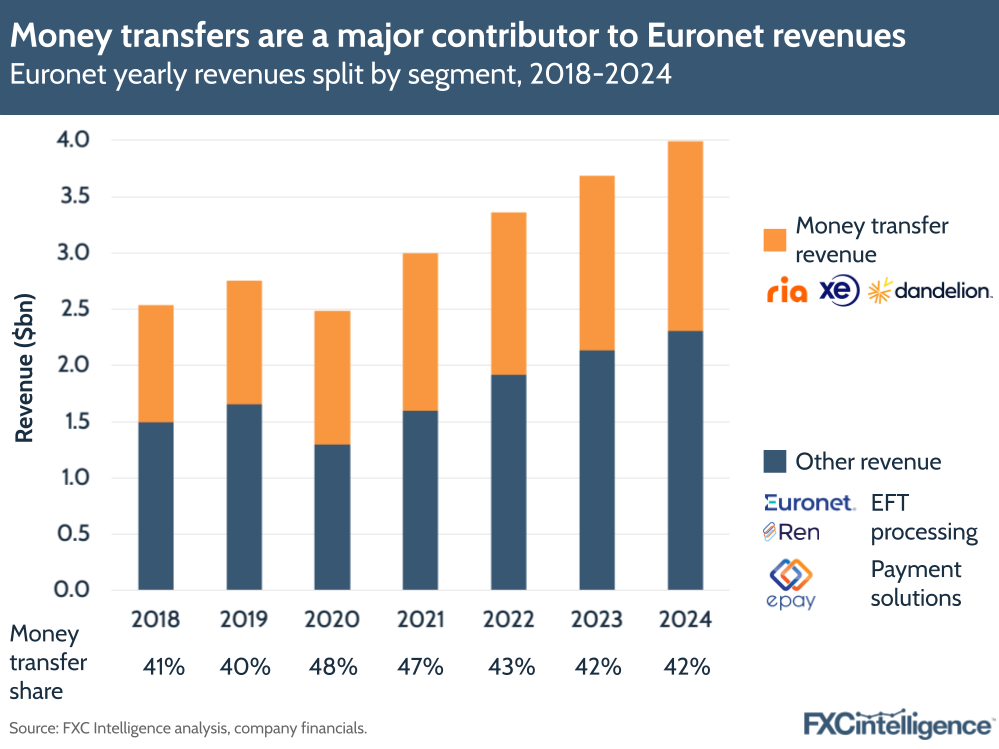
Following a significant drop in 2020, EFT processing revenue has risen at the fastest rate, a trend that continued in 2024, when it grew 10% to reach $1.2bn. By comparison, the money transfer segment grew by 8% to $1.7bn, while epay grew 6% to $1.2bn.
Having said this, the company noted that Euronet’s mix has shifted further away from ATMs specifically. As a share of revenue, ATMs declined from 25% in 2019 to 19% in 2024, driven by other revenue streams growing more quickly and growing investments in areas like Dandelion, digital money transfers and payment processing platforms.
Executives said the company is currently originating transfers from about 60% to 65% of the global remittances market and that it aims to continue to expand to new markets with the goal of eventually capturing about 80-85% of the market. Reflecting this, the number of Ria network locations has continued to expand and is now over 600,000 – a 5% increase from the year before.
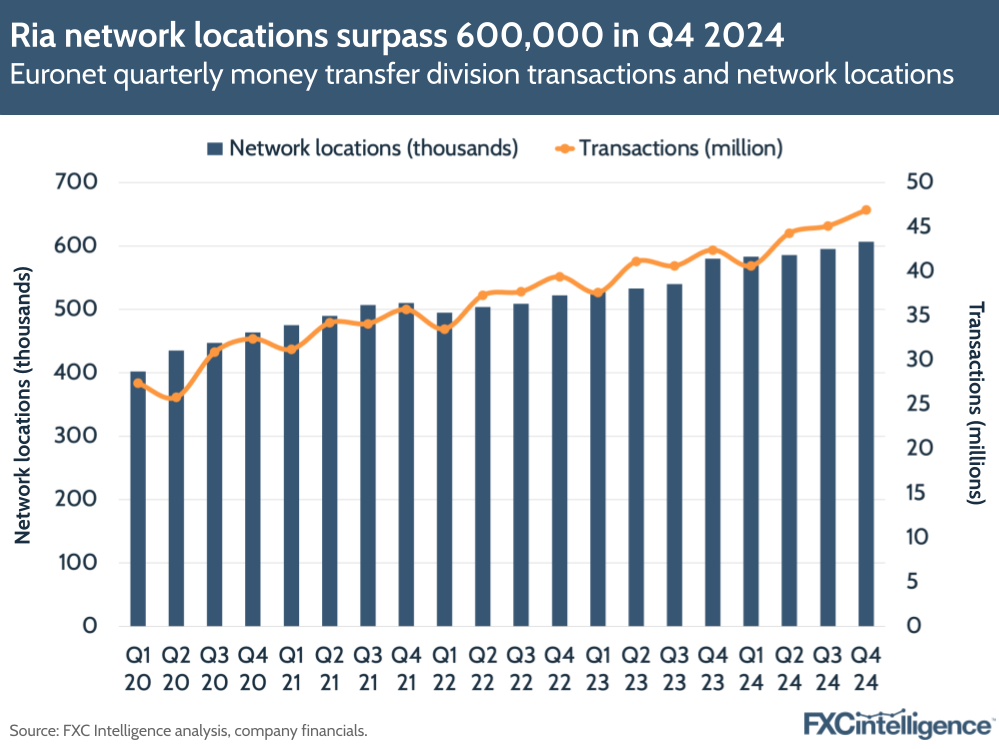
Looking back over time, Euronet has seen transactions rise consistently YoY every quarter after Q2 2020, when transactions declined at the high point of the Covid-19 pandemic. Transactions rose 11% in Q4 2024, with 9% growth to 177 million for the full year.
In addition to transactions themselves, cross-border specifically has also been a key driver for revenue per transaction. Referencing the global payments market, Euronet said its revenue per dollar processed was more than 20 times the market average, though the company still sees significant room to grow in higher value payments. Having said this, for money transfers specifically, the average revenue per transaction has declined slightly since 2023, from $9.62 to $9.53.
Executive VP Rick Weller added that cross-border transactions specifically had been a driver for the company’s strong revenue per transaction, with cross-border transfers also growing “a little faster” within the mix of transactions.
Euronet continues to see digital driving money transfers growth
Euronet has continued its push on digitally originated transactions, which grew 33% during the quarter – the fastest growth for this metric since Q1 2023 – and digital transactions continue to see faster growth than transactions overall.
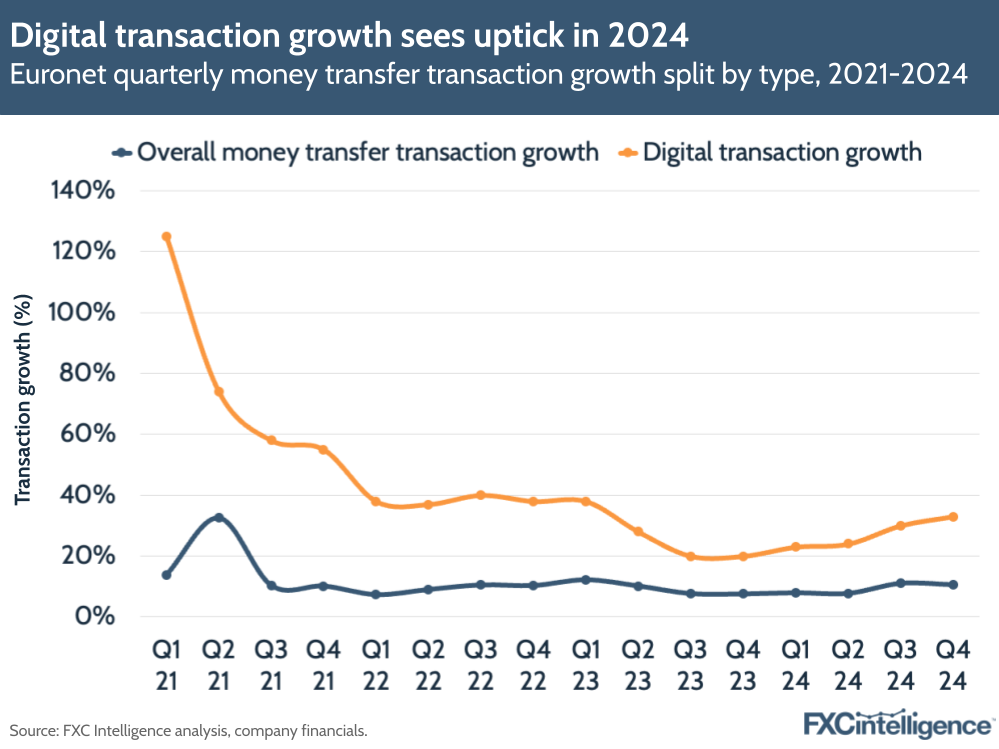
The company also noted that digital payouts grew 31% compared to the previous year and represented 54% of its total volumes. This highlights the company’s shift to addressing online customers, which Euronet along with other remittances players have increasingly moved towards as other digital players (e.g. Remitly) continue to grow their share of the market.
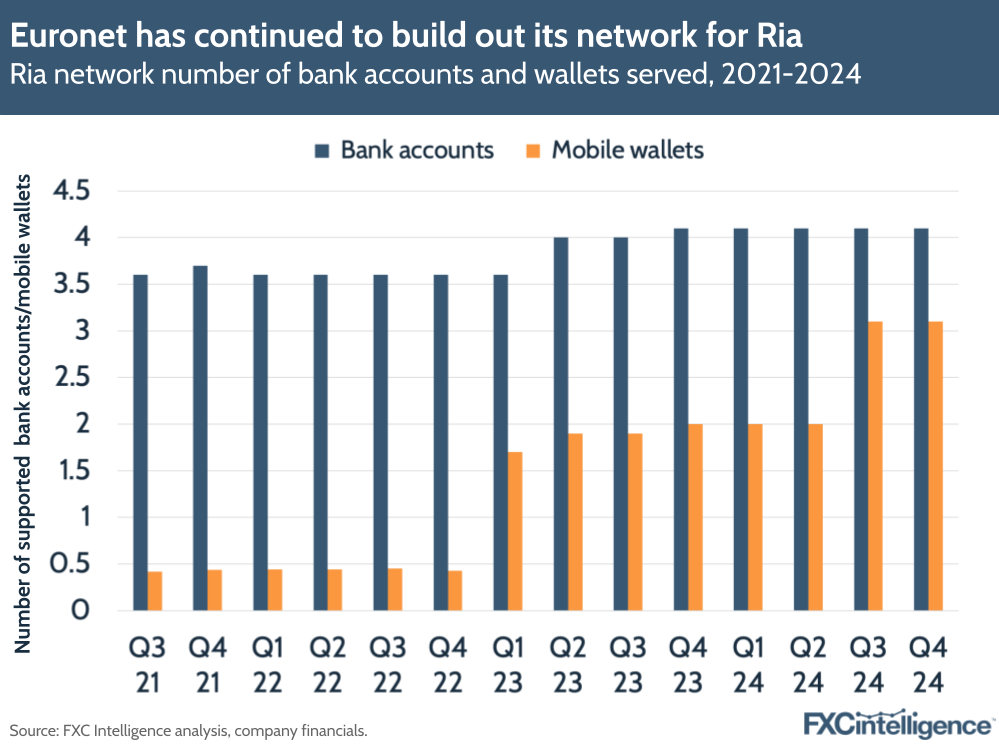
Aside from the retail locations accessible through its Ria network, Euronet now supports payouts to 4.1 billion bank accounts and 3.1 billion wallet accounts. While the number of mobile wallets served by Euronet hasn’t changed since the previous quarter, the continued upward trend of supporting digital wallets is another indicator of the company’s move towards digital services.
Inside the Dandelion global payments platform
The significance of Euronet’s continued market expansion isn’t limited to its own money transfer offerings, but also Dandelion – the company’s payments infrastructure brand, which is essentially the same infrastructure that it built to power Ria and Xe but has been repackaged as a wholesale cross-border payments network for banks and payment companies. Dandelion effectively allows banks and fintechs to bypass correspondent banking networks and quickly expand payments coverage into more areas.
Launched in 2021, Euronet now calls Dandelion the world’s largest real-time cross-border payments network, enabling payments to 195 countries across 117 currencies and powering more than 148 million transactions annually. The launch came as the company shifted to deliver more global payments solutions and looked to diversify into platforms off the back of its existing infrastructure in order to help it maintain profitability in the future.
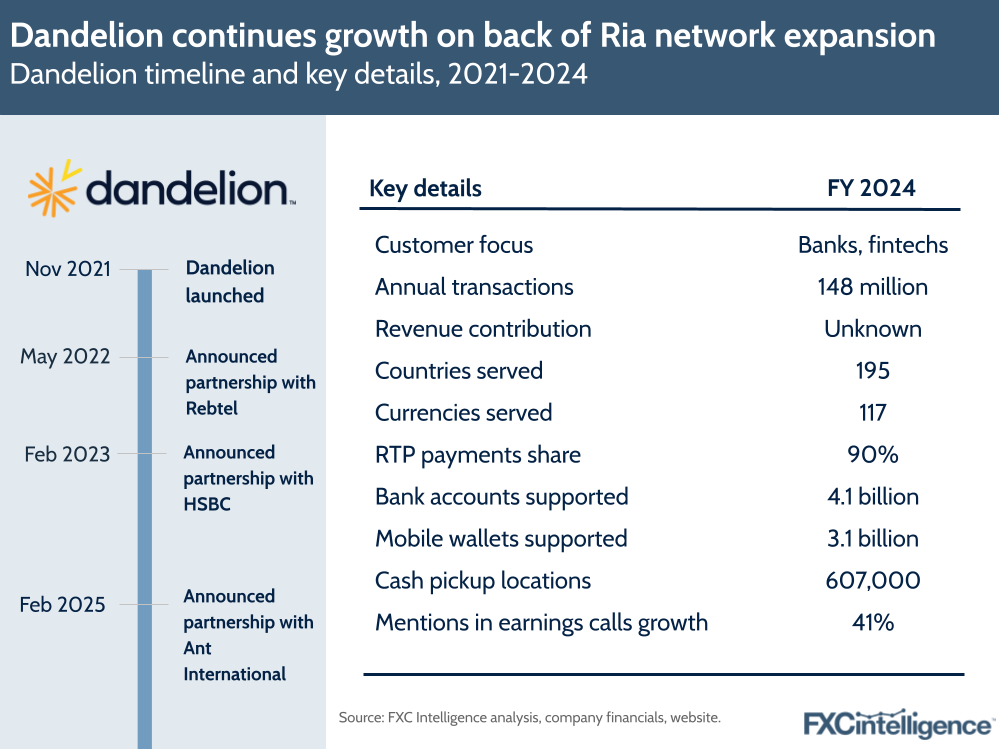
Dandelion has often been referred to in passing in Euronet’s earnings, with the company primarily highlighting key partnerships with major banks in the space. It has rarely broken out Dandelion’s impact on revenues or overall transactions in much great detail – it last reported the platform’s revenue growth in Q3 2022 as being 44%, while transaction growth was 45% in Q2 2023.
This could be because many of the deals around Dandelion have still yet to come to fruition or have a meaningful enough impact to share with investors in greater detail. However, there are a number of reasons why Dandelion’s overall relevance to Euronet appears to be growing.
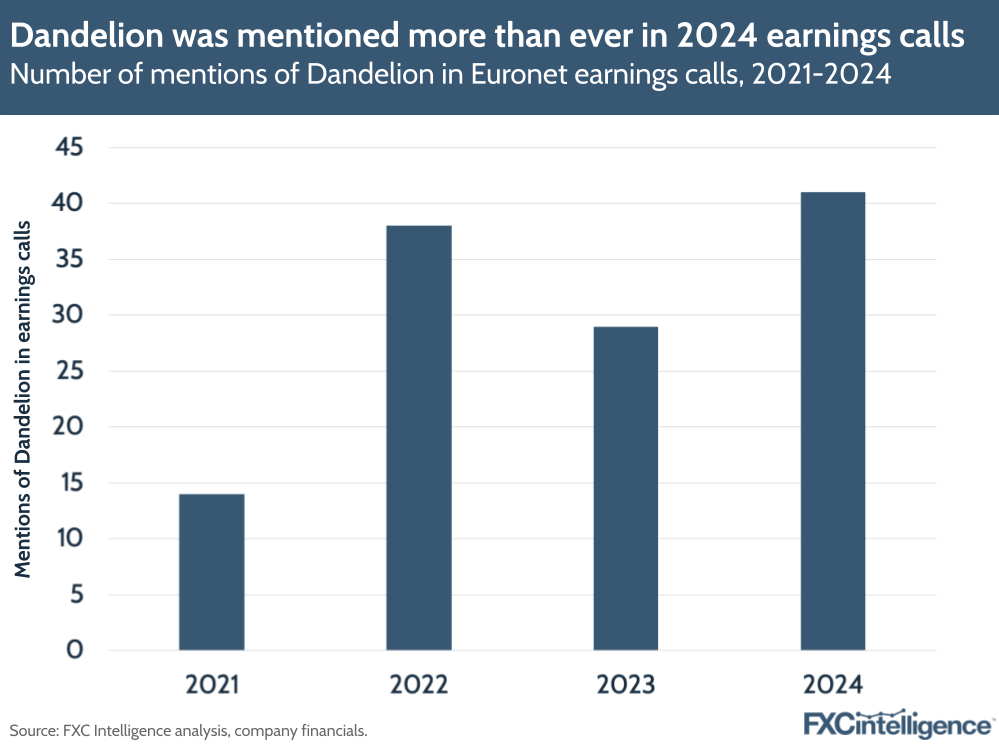
Dandelion was mentioned 41 times in Euronet’s earnings calls in 2024, compared to 29 times the previous year and 14 times in 2021 (though this only covers the last quarter, when Dandelion was announced).
This growing discussion of Dandelion reflects moves made by other companies in the space that are looking to sell their payments networks as a product to other players, who themselves are looking to quickly expand payments capabilities to new markets. This includes Wise with Wise Platform, as well as Visa and Mastercard through Visa Direct and Mastercard’s Cross-Border Services.
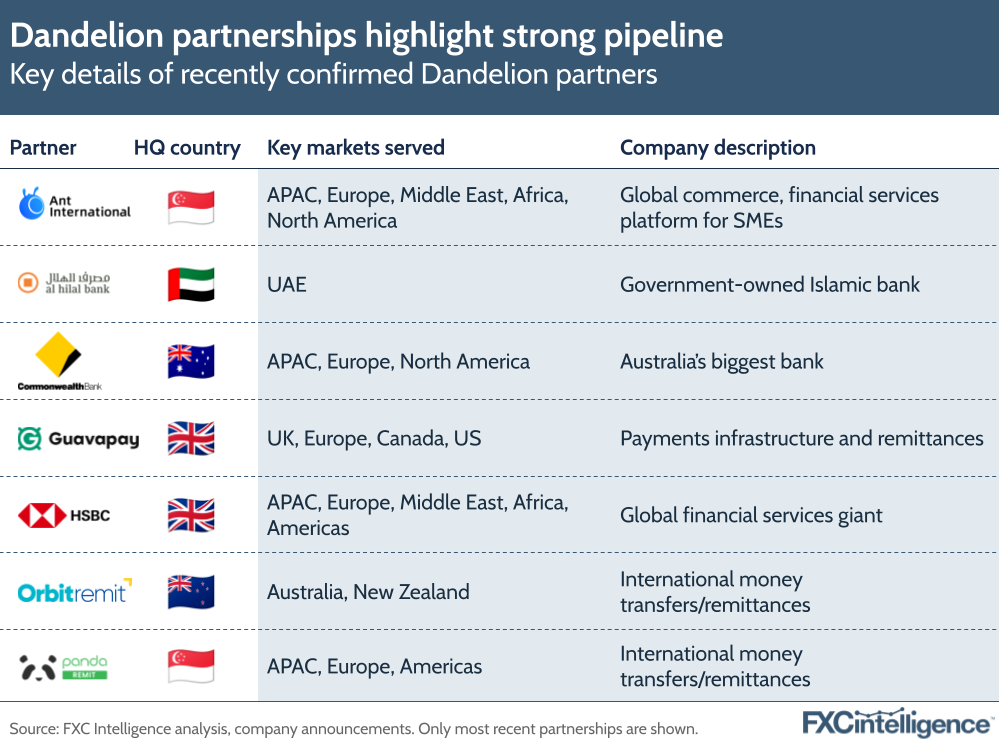
The company has noted several sizeable new partnerships in 2024, with many of these being focused on companies with an APAC focus, such as global commerce player Ant International, which already owns its own cross-border payments platform Alipay+. The focus for recent partnerships appears split between major banks such as HSBC, the Commonwealth Bank of Australia and Al Hilal Bank, and remittances companies such as Guavapay, OrbitRemit and PandaRemit.
On HSBC’s role, Euronet CEO Michael Brown expressed that HSBC – which is using Dandelion to facilitate C2B and B2B payments and has been live on the platform for around 16 months – has recorded “record” growth every month during that period, though he didn’t specify if this was in relation to number of transactions or volumes.
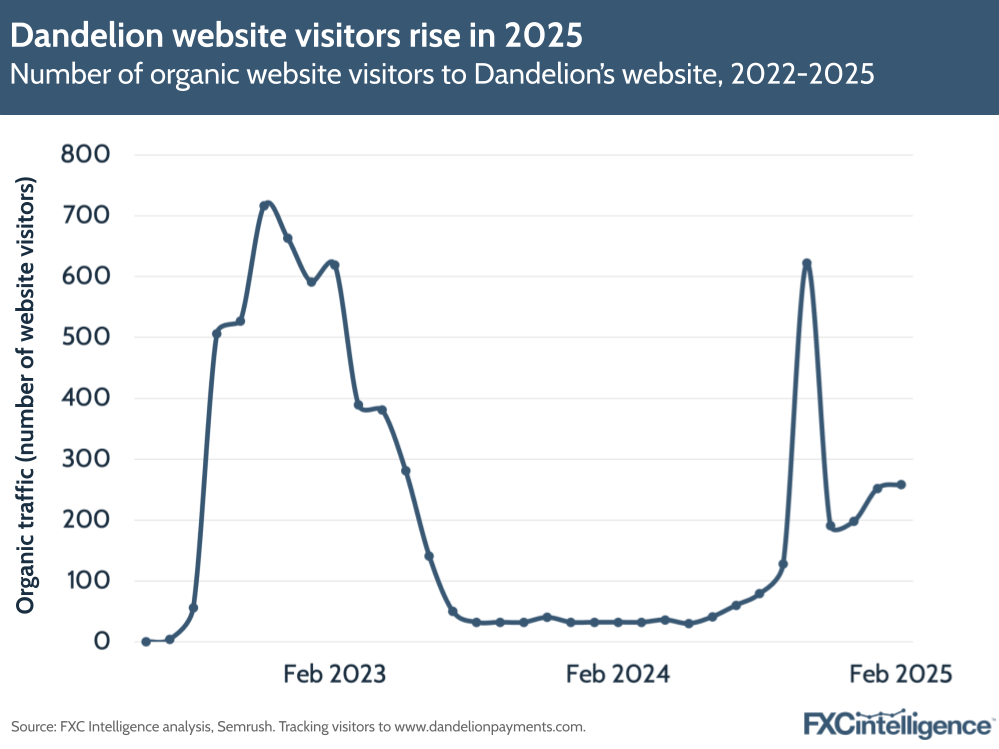
The number of organic website visitors to Dandelion Payments’ website has changed over time. After peaking in 2023, the number of people searching for and subsequently visiting Dandelion Payments fell in the second half of 2023 and plateaued for around a year afterwards.
The website began picking up traction again in late 2024 however, with high traffic recorded in October. While it isn’t known what has caused this peak in interest, it is notable that the company was repeatedly in the news as a result of it announcing further details on its partnership with HSBC at last year’s Singapore Fintech Festival, having previously landed the major bank as a client in February 2023.
The company saw a 43% drop in organic traffic as recorded by Semrush in 2024, but on a monthly basis organic traffic has continued to pick up for Dandelion in 2025, aligning with its more frequent mentions in earnings calls.
Euronet’s future outlook
Going forward, Euronet is expecting to drive 12-16% earnings per share growth in 2025. Though it didn’t specify a revenue outlook for its money transfer segment, this will likely continue to be a driver for 2025 – particularly as the company noted increasing its remittance TAM during the quarter through expansions to Mexico, the Philippines and Thailand outbound market.
These markets are particularly engaged in digital payment methods and could expand the company’s already rapid transaction growth in this area. However, with Dandelion continuing to pick up traction amid a wider industry push towards platforms as products, we could soon see Euronet’s impact as a provider of payments infrastructure begin to emerge.



